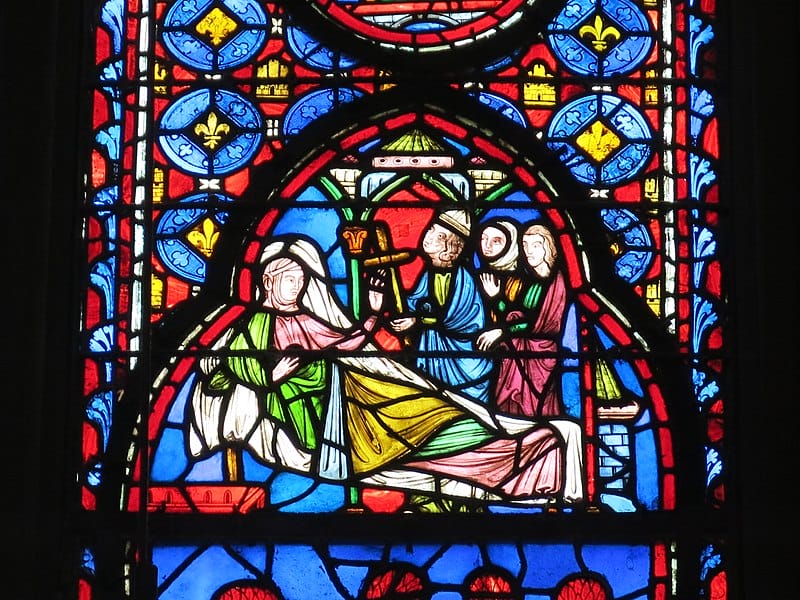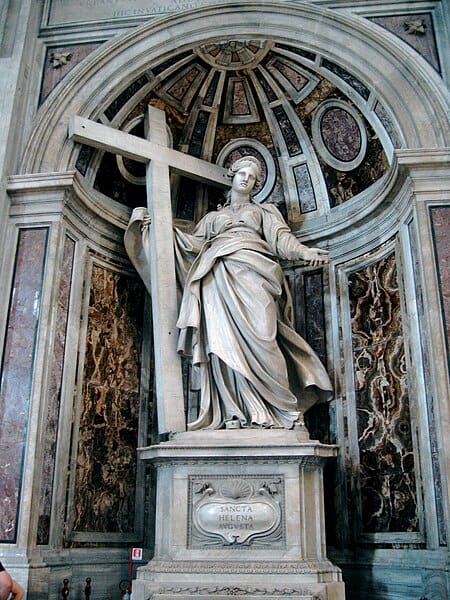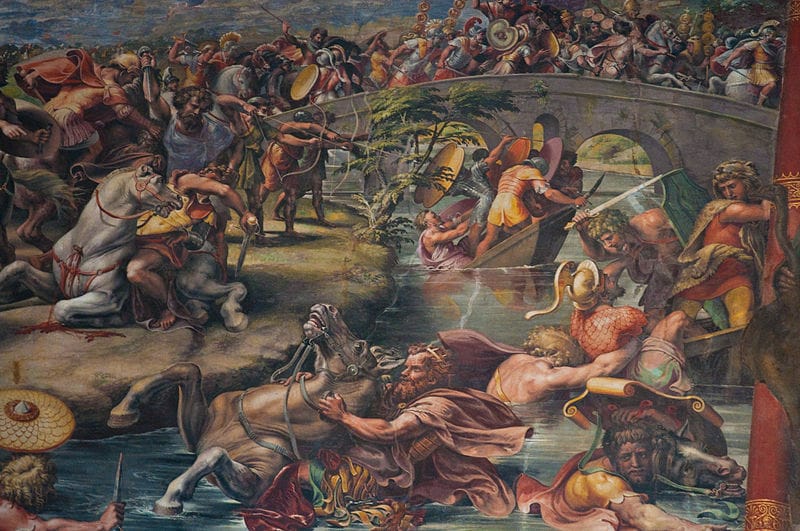Helena of Constantinople, also known as Saint Helena, is a celebrated figure in Christian history, admired for her devout life and her legendary quest that led to the purported discovery of the True Cross. As the mother of Emperor Constantine the Great, her influence extended not only within the realms of imperial power but also into the spiritual fabric of the Christian Church. She embarked on a significant pilgrimage to the Holy Land, which emphasized her commitment to her faith and contributed to the spread of Christianity.

Helena’s role in Christianity was enormous, as she was not only an empress but also a force of change within the church. Her contributions and zealous acts, the construction of churches at key biblical sites, and her efforts to locate the True Cross are the most important episodes in early Christian history. Her veneration as a saint after her death further solidified her status as a key figure within the faith, and her story continues to be told as an exemplar of piety and dedication in Christian communities around the world.
Key Takeaways
- Saint Helena’s pilgrimage and search for the True Cross represent her deep Christian faith.
- As Empress and mother of Constantine, she significantly influenced early Christianity.
- Helena of Constantinople is venerated as a saint, reflecting her lasting legacy within the Christian Church.
Early Life and Marriage of Helena of Constantinople
Helena of Constantinople, later known as Saint Helena, experienced a remarkable journey from obscure beginnings to becoming the mother of Constantine the Great, one of history’s most important emperors. Her life intertwined with key figures of her time, setting the stage for her son’s rise to power and her own significant influence within the empire.
Rise from Humble Beginnings
Helena of Constantinople was born in the early 3rd century in Drepanum, a city in the province of Bithynia in Asia Minor. Even though she came from humble roots, some accounts suggest she was the daughter of an innkeeper, possibly a stable maid (Stabularia), which emphasizes the dramatic nature of her ascent within Roman society. Despite the low status of her birth, Helena’s destiny would shift dramatically through her associations and the social mobility she later achieved.

Relationship with Constantius I
Her path to prominence began when she formed a relationship with Constantius I, a Roman military officer who would later become a Caesar and then an Augustus within the Tetrarchic system established by Diocletian. While the details of their union are sporadic, it is believed that Helena and Constantius were either legally married or in a form of concubinage that was common for soldiers at the time. Their connection brought Helena into the sphere of the Roman elite, setting the foundation for her future influence.
Mother to Constantine the Great
The most consequential result of Helena’s union with Constantius I was the birth of their son, Constantine I, also known as Constantine the Great. Born in Naissus, the precise date of his birth is still debated, yet it marked the beginning of a new dynasty. After Constantius I rose to power, he left Helena to marry Theodora, the stepdaughter of Emperor Maximian. This separation did not hinder Constantine’s prospects, and Helena of Constantinople remained a central figure in her son’s life, particularly after he recognized her as Augusta following his ascension as emperor. Helena’s influence was significant both in the early life of Constantine and later as he ruled the Roman Empire.

Source: Phillip Capper from Wellington, New Zealand, CC BY 2.0 https://creativecommons.org/licenses/by/2.0, via Wikimedia Commons
Role in the Christian Church
Empress Helena of Constantinople had a substantial impact on the growth of Christianity through her conversion, patronage, and active role in church-building, which fostered the expansion of the faith across the Roman Empire.
Conversion to Christianity
Empress Helena’s conversion to Christianity played a critical role in its endorsement within Roman society. Her influence as the mother of Constantine the Great was instrumental, as she is believed to have affected her son’s favorable approach towards the religion. Historically, her conversion is marked as a significant event that contributed to the Christian church’s transition from persecution to acceptance.
Patronage and Influence
As a patron, Helena exhibited remarkable influence within the early Christian church. She is honored across various denominations, including the Catholic Church, the Anglican Communion, the Lutheran Church, the Oriental Orthodox, and the Eastern Orthodox churches. The support of Helena of Constantinople extended financial assistance and legitimization to Christianity during a time when the religion was not yet fully established in the empire.
Building of Churches
Empress Helena’s noteworthy contributions included the building of churches at key religious sites. Known for her building projects in Rome and the Holy Land, these edifices served as foundational landmarks in the Christian world. They not only provided places of worship for early Christians but also established significant pilgrimage sites that hold great importance in Christian history to this day.
Quest for the True Cross
Helena of Constantinople, mother of the Roman Emperor Constantine, embarked on a determined journey that would mark her as one of early Christianity’s most significant figures. Through her endeavors in the Holy Land, Helena of Constantinople is credited with finding a relic of monumental importance to the Christian faith – the True Cross.
Pilgrimage to the Holy Land
In the early fourth century, Helena of Constantinople undertook a pilgrimage to the Holy Land. This was no ordinary visit; it had religious motivations. She traveled to various locales significant to Christian tradition, including Jerusalem and Bethlehem, with a dedicated purpose: to find the relics of Jesus Christ. Amidst her journey, she initiated church construction and influenced the landscape of the Holy Land with her piety and dedication.
Discovery and Legacy
The pinnacle of Helena’s pilgrimage is renowned for the discovery of the True Cross. Tradition holds that she discovered the Cross, believed to be the very one upon which Jesus was crucified and buried under a pagan temple. Upon unearthing three crosses, a miraculous healing during a test led Helena and her entourage to identify the True Cross. This monumental find not only bolstered Christian reverence for relics but also significantly impacted Christian iconography and the religious significance of Jerusalem within the Roman Empire. The legacy of Helena’s quest can be felt even today, as the True Cross remains a symbol of faith and a much-adored relic.

Death of Saint Helena
Saint Helena is believed to have died around the year 330 AD. The exact date of her death is not definitively known, but it is commonly placed around this time based on historical accounts. She was approximately 80 years old at the time of her death, having been born around 248 AD. Helena spent her later years in the Eastern part of the Roman Empire, likely living in Constantinople or nearby regions. Her death is traditionally associated with Nicomedia, a city in Bithynia in Asia Minor, where she is thought to have spent some of her final years.
Legacy and Burial
After her death, Helena was buried in the Mausoleum of Helena outside Rome. The mausoleum is located near the catacombs of the Via Labicana. Her sarcophagus, which is made of red porphyry, was later moved to the Vatican Museums, where it remains today.
Veneration and Sainthood
Canonization and Feast Days
Helena of Constantinople, the mother of Emperor Constantine the Great, enjoys the honor of sainthood across multiple denominations within Christianity. In the Eastern Orthodox Church, Helena is revered as a saint, and her memory is celebrated with a Feast Day on May 21. The Roman Catholic Church also recognizes her contributions to Christianity and her sanctity, celebrating her feast day on August 18. Similarly, the Coptic Orthodox Church venerates Helena as a saint, honoring her religious commitment and discovery of the True Cross, a central relic in Christian tradition.
Legacy in the Arts and Culture
Throughout history, Saint Helena of Constantinople’s legacy has been immortalized in the arts and culture. She has been the subject of various artworks that often depict her finding of the True Cross, a moment that solidified her veneration and lasting significance in Christianity. Notable representations include mosaics, paintings, and literature that celebrate her faith and piety. Additionally, many churches and shrines are dedicated to her, serving both as places of worship and as reminders of her impact on religious heritage. The presence of relics attributed to Saint Helena adds to her respected status within Christian history, serving as concrete connections to her saintly life.
People Also Ask:
How did Saint Helena contribute to Christianity?
Helena of Constantinople is revered for her support in the construction of churches at significant sites of Christian history, most notably in Jerusalem and Bethlehem. She is also celebrated for her role in the promotion and spread of Christianity within the Roman Empire during its pivotal early days.
What was the influence of Saint Helena on Emperor Constantine?
As the mother of Emperor Constantine, Saint Helena is believed to have been a pivotal figure in his conversion to Christianity and his subsequent policy of religious tolerance. Her influence helped shape Constantine’s reign, which led to the widespread acceptance of Christianity across the empire.
In what ways is Saint Helena commemorated in the Christian tradition?
Helena of Constantinople is commemorated through feast days in the Western and Eastern Christian churches. She is often venerated as a saint, and churches and shrines have been dedicated to her, celebrating her life and her contributions to the Christian faith.
What discoveries is Helena of Constantinople credited with during her pilgrimage?
During her pilgrimage to the Holy Land, Saint Helena is credited with discovering the relics of the True Cross, upon which Jesus was crucified. This momentous find has attached great historical and religious significance to her name and journey.
What historical evidence exists regarding Saint Helena’s life?
Historical accounts, though sparse and sometimes contested, describe Helena’s life from her early years to her death. This evidence includes her birthplace, her marriage to Constantius, and her rise to prominence as the mother to Constantine the Great.
How has Saint Helena been depicted in art and literature?
Saint Helena’s depiction in art and literature is informed by her significance as a Christian figure. Helena of Constantinople appears in a variety of media, embodying themes of piety and religious devotion, and is often portrayed in the act of discovering the True Cross, solidifying her legacy within Christian iconography.
Hello, my name is Vladimir, and I am a part of the Roman-empire writing team.
I am a historian, and history is an integral part of my life.
To be honest, while I was in school, I didn’t like history so how did I end up studying it? Well, for that, I have to thank history-based strategy PC games. Thank you so much, Europa Universalis IV, and thank you, Medieval Total War.
Since games made me fall in love with history, I completed bachelor studies at Filozofski Fakultet Niš, a part of the University of Niš. My bachelor’s thesis was about Julis Caesar. Soon, I completed my master’s studies at the same university.
For years now, I have been working as a teacher in a local elementary school, but my passion for writing isn’t fulfilled, so I decided to pursue that ambition online. There were a few gigs, but most of them were not history-related.
Then I stumbled upon roman-empire.com, and now I am a part of something bigger. No, I am not a part of the ancient Roman Empire but of a creative writing team where I have the freedom to write about whatever I want. Yes, even about Star Wars. Stay tuned for that.
Anyway, I am better at writing about Rome than writing about me. But if you would like to contact me for any reason, you can do it at contact@roman-empire.net. Except for negative reviews, of course. 😀
Kind regards,
Vladimir
